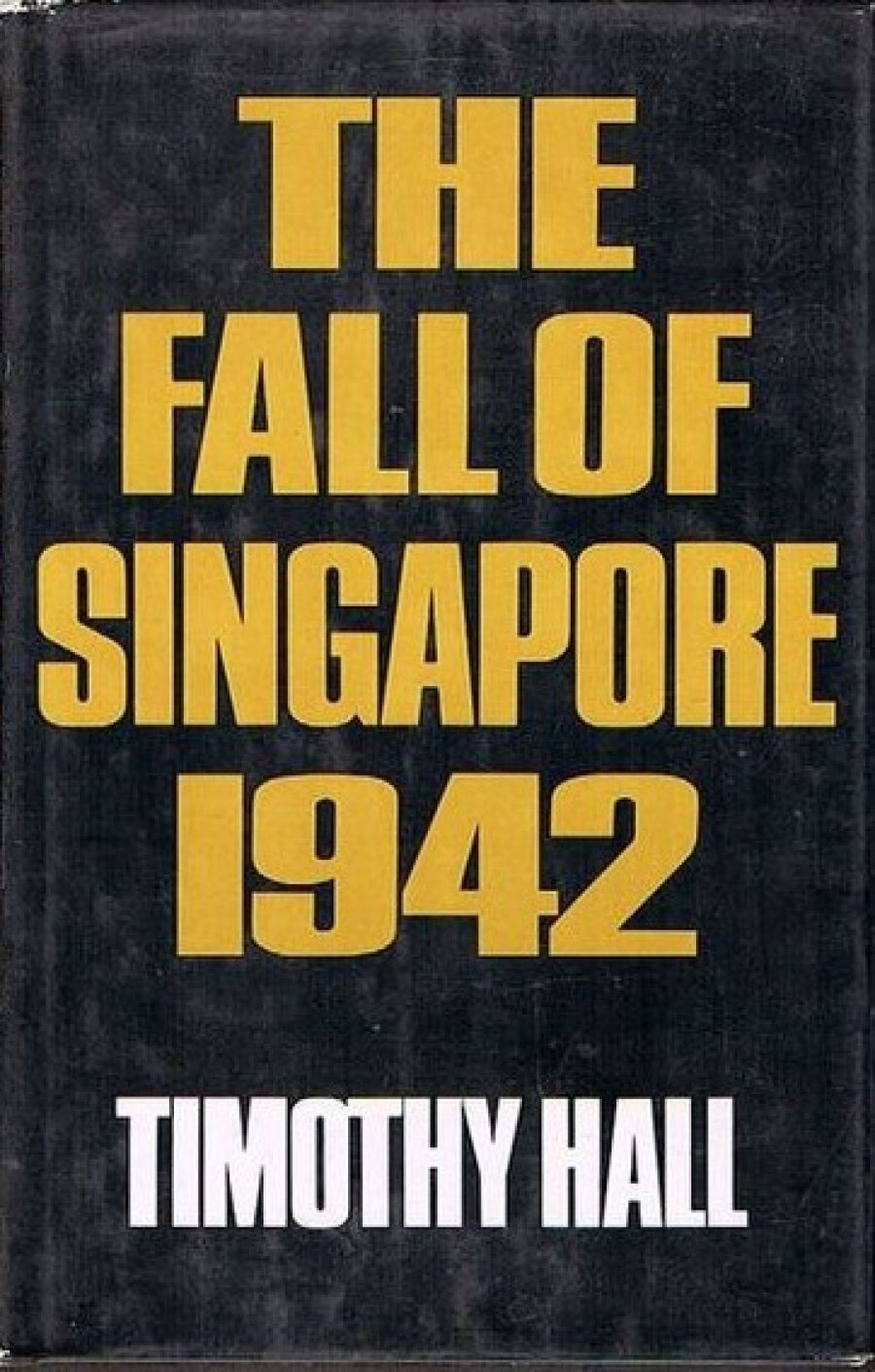
- Free Article: No
- Contents Category: War
- Review Article: Yes
- Article Title: Fall and resist
- Online Only: No
- Custom Highlight Text:
Timothy Hall has written a brief readable account of the lamentable Malayan campaign. but over the past forty years the story has been told more accurately and more dramatically by a succession of authors, many of whom were participants in that tragic debacle.
This obviously swiftly researched book is flawed by a number of omissions and exaggerations.
- Book 1 Title: The Fall of Singapore 1942
- Book 1 Biblio: Methuen, $17.95, 223 pp
- Book 1 Readings Link: www.booktopia.com.au/the-fall-of-singapore-1942-timothy-hall/book/9781138912427.html
Mr Hall frequently refers to the 22nd brigade but seems unaware of its earliest and most successful operation against the Japanese. This was a large-scale ambush carried out in January 1942 at Nithsdale rubber estate between Mersing and Jamaluang by the 2/18 and 2/20 battalions supported by the 2/10 field regiment. These units inflicted heavy casualties on the enemy with comparatively light losses to themselves. A Japanese account of the action describes the fighting near Jemaluang as ‘an appalling hand-to-hand battle’.
On the other hand, Mr Hall makes much of groups of soldiers and airmen wandering ‘leaderless and without orders through city streets’. He claims that ‘many of them were armed, many were drunk and bullied civilians in the streets and looted at will’. He embellishes this exaggeration with a statement that these men seemed to be all over Singapore and that ‘creme-de-menthe was a favourite drink for the Australian troops who wanted to get drunk’.
At that time this reviewer, who was a member of an artillery battery with guns constantly on the move, failed to observe these extraordinary happenings and none of his mates can recall them either. They were too busy.
No doubt there were a few ugly incidents but it must be remembered that as late as 24 January 1942 over 1,900 untrained reinforcements arrived from Australia, some of them with defective rifles. Stan Arneil recalls that in February 1942, just before the battle for Singapore, his unit (2/30 Bn) received recruits who have been enlisted three weeks before that time. Many had not only not fired a rifle but had never actually handled one!
In such circumstance there was bound to be some confusion in getting such reinforcements to units in action.
The book has a full-page photograph of Major-General Gordon Bennett with his slouch hat on the wrong way around and wearing his service ribbons on the right instead of the left side of his tunic. Someone printed the negative in reverse. The Fall of Singapore 1942 is easy reading but superficial.
 Black Jack: The life and times of brigadier Sir Frederick Galleghan by Stan Arneil
Black Jack: The life and times of brigadier Sir Frederick Galleghan by Stan Arneil
Macmillan, $16.95, 178 pp
Stan Arneil has written a sympathetic and sensitive biography of a remarkable but not altogether likeable man. His book is also a tribute to the family-like links developed in 2nd AIF units and surviving to this day. This bond is probably more enduring among those who were prisoners of the Japanese because their chance of survival depended on comradeship and mutual help and trust.
One of the most moving passages in this book is where Arneil describes the return to Changi of the survivors of F force from the Burma–Thailand railway. Black Jack Galleghan was there to meet the emaciated repatriates as they paraded at the end of the journey:
‘Where are the rest, major?’
‘They’re all here sir.’
Galleghan could not speak: of the 651 soldiers of his own unit who had gone north with F force, 192 had died in seven months. Of the force of 7000 British and Australians almost half were dead.
Unspeaking he walked along the line of men patting the shoulders of a man here and there, the tears streaming down his face.
He turned to his officers and the waiting prisoners from Changi: ‘Look after them, lads,’ he said and took his grief to his hut.
The author has obviously maintained a long and close association with his hero both in and out of the army. He does not hesitate however to reveal characteristics of Black Jack which did not endear him to men of units other than the 2/30 battalion, some of whom thought his actions at Changi somewhat unbalanced at times. When he berated the Japanese guards for untidiness, for example, many Australians thought he was more than eccentric.
Black Jack emerges as a man with a chip on his shoulder, based probably on imagined racial discrimination because of a shade of colour bequeathed to him by grandparents born in the West Indies. (I was never aware of any racial discrimination in the AIF). In spite of this, he had a distinguished military career culminating in his promotion to major-general.
Stan Arneil pays tribute to the bravery and discipine of his battalion and is justly Proud of its record in the Malayan campaign. He credits its success to the ruthless training methods of Black Jack.
Other units however achieved equally heroic results under less fanatical disciplinarians, such as the 2/19 Bn under Lt Colonel C.W.G. Anderson VC, MC.
On his return to civil life Black Jack was to distinguish himself further, ending his career as Head of the Commonwealth Investigation Service. He received a knighthood in 1960 and was dubbed a Knight Bachelor by Lord Casey on 11 April 1969.
Black Jack died in 1971 and Stan Arneil’s book is a fitting memorial to an outstanding Australian.


Comments powered by CComment